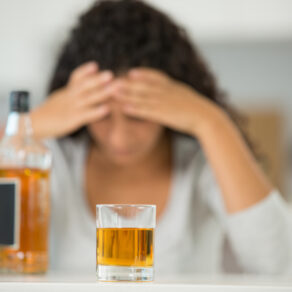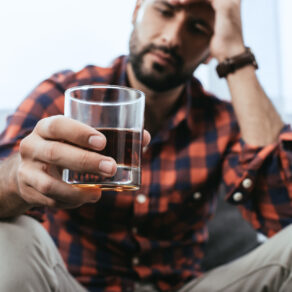**Caution** This article touches on depression and suicide
*If you need suicide- or mental health-related crisis support, please call or text the 988 Suicide and Crisis Lifeline or chat with Lifeline to connect with a trained crisis counselor.*
By my count, I should be dead at least 6 times.
Ninety-five percent of the time, I’d say my drinking wasn’t a problem. That percentage kept me in denial. I considered myself a “normal” drinker. I could control it. I could moderate whenever I wanted.
Still, that binge drinking five percent could turn things ugly. Binge drinking wasn’t a problem for me, until it was. And the reality is that blackouts are a common side effect of this behavior. There are probably incidences of recklessness, I simply don’t remember.
My commercial fishing occupation as a lifestyle didn’t help my stuck pattern either, but that’s another story.
In this story of my history, one day, 4 years ago, I woke up after my last unexpected late night out drinking in which my recklessness could have ended in death. The next morning, filled with conflicting emotions of anxiety, shame, fear, I couldn’t deny it any longer. It was time. I needed to figure out how to change. I felt my luck would inevitably run out.
Scott, my late husband, wasn’t so lucky. He died twelve years ago due to an alcohol-related suicide and now is counted as a statistic. A year or so later, trying to process it, I promised myself I would find some way to give back in honor of his memory, but how?
Mental health is something I never really paid attention to until it affected me personally. Isn’t that common with most things in life? My depression hit me hard about a year after my husband’s death, yet having never suffered from it, I was unaware that I was in its grip. My mother noticed, suggested I get some help. I refused, played the tough card. I told myself I could do it on my own. I’ll be okay. Thankfully, I came out on the other side, but it would have been so much easier to have asked for help. A proud moment for me – not too long ago with my last drinking escapade – was realizing and courageously beginning that first step of seeking help. I didn’t try to do it alone. That final night of drinking has become my last night.
As a misguided reformed drinker, I have found my way, creating a new chapter in my 60’s that I am very proud of. As a health coach, alcohol free coach, speaker, soon to be the author of Life Beyond the Binge, my dream is to make an impact, to motivate toward positive change, one person at a time, beginning with myself. My newfound purpose is to spread awareness, open communication, connect, and find solutions.
But I’m still learning. I’m still searching for peace, for my sacred home since I now know the material home is ever changing. What does peace mean? For me, it’s finding a home within an internal world that is mine. In the aftermath of my late husband’s suicide, did I look back and think I should have done or said things differently? Absolutely. But there is grace in my knowledge, in knowing that some answers are difficult and indeed may never be found. Allow the pain to surface, and move forward, in Scott’s name, and for my name, Colleen, the one left breathing. This is the answer to my how.
Thank you for reading.
With permission, I am sharing the information below from the NIAAC.
How Common Is Binge Drinking?
According to the 2023 National Survey on Drug Use and Health (NSDUH), about 61.4 million, or 21.7%, of people in the United States ages 12 and older reported binge drinking during the past month.
The National Institute on Alcohol Abuse and Alcoholism (NIAAA) defines binge drinking as a pattern of drinking alcohol that brings blood alcohol concentration (BAC) to 0.08%—or 0.08 grams of alcohol per deciliter—or more. This typically happens if a woman has four or more drinks, or a man has five or more drinks, within about 2 hours.1 Research shows that fewer drinks in the same time frame result in the same BAC in youth: only three drinks for girls and three to five drinks for boys, depending on their age and size.
What Are the Consequences and Health Effects of Binge Drinking?
Although drinking any amount of alcohol can carry certain risks (for information on impairments at lower levels, please see the NIAAA BAC-level infographic), crossing the binge threshold increases the risk of acute harm, such as blackouts and overdoses. Binge drinking also increases the likelihood of unsafe sexual behavior and the risk of sexually transmitted infections and unintentional pregnancy. These risks are greater at higher peak levels of consumption. Because of the impairments it produces, binge drinking also increases the likelihood of a host of potentially deadly consequences, including falls, burns, drownings, and car crashes.
• Alcohol affects virtually all tissues in the body. Data suggests that even one episode of binge drinking can compromise functions of the immune system and lead to acute pancreatitis (inflammation of the pancreas) in individuals with underlying pancreatic damage. Over time, alcohol misuse, including repeated episodes of binge drinking, contributes to liver and other chronic diseases as well as increases the risk of several types of cancer, including head and neck, esophageal, liver, breast, and colorectal cancers.
• Binge drinking can be deadly. According to the U.S. Centers for Disease Control and Prevention (CDC), approximately 178,000 deaths resulted from excessive alcohol use* annually in the United States between 2020 and 2021. One third of those deaths** were from binge drinking or drinking too much on one occasion.
Please don’t become a statistic – with love, Colleen










